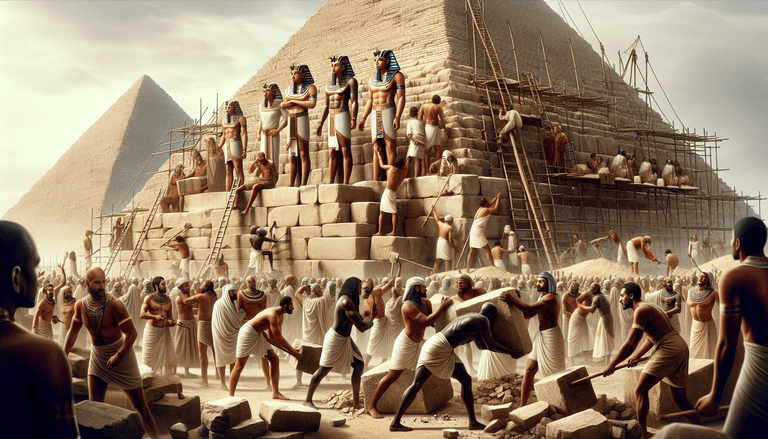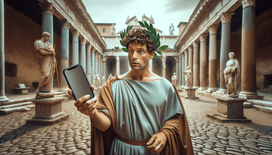Imagine, if you will, the ancient Egyptian desert, where the sands once whispered stories of gods and kings. But instead of scribes chipping away on clay and papyrus, there's something modern in the air: the sweet aroma of social media. Yes, dear readers, we're diving into an alternate universe where savvy Pharaohs have Instagram and they're not afraid to use it. Strap on your virtual sandals and journey with me back to a time where selfies and hashtags redefine the landscape of history!
Architecture meets aesthetics
Picture the Great Pyramid of Giza, now adorned with a giant "Under Construction" sign, as emblazoned across the Pharaoh’s Instagram feed. With captions like, "Just laid the 200,000th block! #PyramidProgress", and before-and-after shots, our Pharaohs are set to redefine architectural influence. Forget mystery! This project has step-by-step insights, complete with time-lapse video reels capturing slave labour... I mean, respected worker dedication.
The logistics alone deserve their own ‘Highlight’ on Pharaoh Khufu’s profile. We’d have timelapse stories of pyramid construction, the original ‘building the Earth’s largest structure’ challenge. We’d also see behind-the-scenes peeks, the Great Pyramid would make for the most epic of Instagram stories. "Tune in live at 8 pm, as the capstone goes on!" they’d post, thrilling an audience with an insatiable appetite for both history and hieroglyphics.
Anubis as the ultimate influencer
Enter Anubis, the jackal-headed god of mummification and the afterlife, and the original goth influencer. With a knack for captivating the afterlife chic, his posts would certainly be trending under #DeathIsTheNewBlack. Meanwhile, Pharaohs like Khufu would find themselves following deities not out of religious obligation but pure, unadulterated Insta-envy.
With Anubis’s expert eye, we’d see sophisticated aesthetic guidance materialise in posts about embalming processes, open only to those who are daring enough to "enter the underworld." Just imagine: "Top 10 tips for a stylish sarcophagus” making the rounds in every major centre from Memphis to Thebes.
Ancient "lifestyle" influencers
The Pharaohs, being the leaders they are, would double up as lifestyle influencers, giving us more than a peek into their gilded lives. #PharaohFit would be trending, alongside exercise regimens that include traditional chariot chasing, pyramid climbing, and ten rounds with the sacred ibises. Indulgent shots of lounging by the Nile, feasting on figs, grapes, and the classics at luxurious banquets would fill our Instagram feeds with opulence.
The queens wouldn’t be outdone either. Cleopatra’s skincare routine would go viral. We’d all be smearing honey and donkey milk on our brows before bed, courtesy of livestream tutorials broadcast from the banks of the Nile. "Golden asp snakeskin is the new black," she'd profess, snapping a selfie with her slithery companion.
Mummy Mondays
Not to be outdone, the Pharaohs would most certainly initiate the concept of "Mummy Mondays" where the royal mummies get their personal showcase. Each week, a new mummy would take the spotlight, complete with opensourced discussions about their era and achievements. Royal tomb tours featuring group discussions on artistic techniques, artisan craftsmanship, and an always-engaging Q&A tagged #AskARoyal would delight scholars and casual followers alike.
Armchair historians might even embark on virtual tours through the lens of a drone-eye view soaring over the Valley of the Kings, as live Q&A sessions unravel the suspense behind the spaces in-between the hieroglyphs. "Today we're myth-busting about "Walking Like An Egyptian," they’d announce, and weary workers would take to the comments to debate.
The decline of hieroglyphics?
With the introduction of Instagram and its rapid, filter-enhanced photo media, might we see a decline in the timeless hieroglyphic scroll? Would sending a direct message to Ra the Sun God take precedence over offering tribute and prayer? Perhaps emoji use would lend itself remarkably to the Egyptians written language, providing a shorthand that even scribes would take to graffiti on tomb walls.
Memoirs might be diminished to captions and stories because, after all, a picture speaks a thousand words, or, in this case, a few hundred hieroglyphs. Would some intrepid Pharaoh dare to embed a hashtag in their afterlife plans, striving for posthumous trending status? The possibilities are dauntingly delightful!
Conclusion
So there you have it, a light-hearted romp through the sandy landscapes of an Egypt intertwined with the cyber-threads of the 21st century. It has never been more exhilarating to explore the "What Ifs" of history’s tapestry as we imagine emojis, influencers, and Instagrams painted onto the walls of ancient stone and lore.
While we can only fantasize about a digital antiquity, our little jaunt should remind us that the past, thrilling with mystery and mystique, holds as much charm and intrigue as any timeline we scroll through today. And, perhaps, this realisation is the greatest gift we can take away from imagining a world where Pharaohs hashtag their way into eternity.







